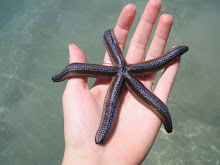Well, I'm not sure how others see it, but here are my thoughts (so far) toward the question of size and self-worth in science. It is so wonderful to contribute to such a coordinated group effort that is, in fact, very unique and very important. However, in the larger scheme of things, delusions of grandeur quickly evaporate. Not because my work isn't important or won't matter, but more because the actual doing of the science is only one of many ways to learn from, share, and build upon this working experience. It is because of these feelings that I hope to get more out of this experience as a person than specifically as a lab technician.
While the rest of the dedicated Microbe group goes on the January expedition, Alice and I are in charge of keeping the project going locally. In science-speak, we are measuring bacterial abundance, production, and community composition by analyzing water conditions, by studying radioisotope incorporation, and by doing predator dilution experiments. For those of you who enjoy a different language, think of bacteria as little critters such as termites, minus the negative connotation. Imagine you wanted to know how much of a wood pile they were eating each day and how fast they grew because of it. The way we do that for bacteria is by feeding them their favorite food that has been specially marked or colored. Because everything is what it eats, the marked food goes into their DNA and we can see it later as they grow. The answers to these relatively simple questions tell us how much carbon can be eaten, digested, and recycled in the food web and how much of it will sink to the bottom of the sea floor for long-term storage. These bacteria are tested from many different places around the station and at different depths so that other nerds, a.k.a. computer modelers, have parameters that help refine their simulations and predictions under different oceanographic conditions.
Phew. So, twice a week, Alice and I will don our float coats to venture out in our Zodiaks, "Bruiser" and "Wonderbread," and collect water. We will then bring it back to the lab and split it up in ten different ways and do twenty different procedures on it. Then we'll do the clean-up. Oh, the clean-up. When we're not in our lab coats, we'll be hiking up our backyard glacier, visiting the nearby islands, pondering the icebergs, soaking in the hot tub, and taking it all in. Not so shabby, eh?







AMANDA! I love your blog and your pictures are AMAZING! Thanks for keeping us all updated. I must say I'm quite jealous of your awesome adventures! Miss you, cuz!
ReplyDeleteLove
Biz